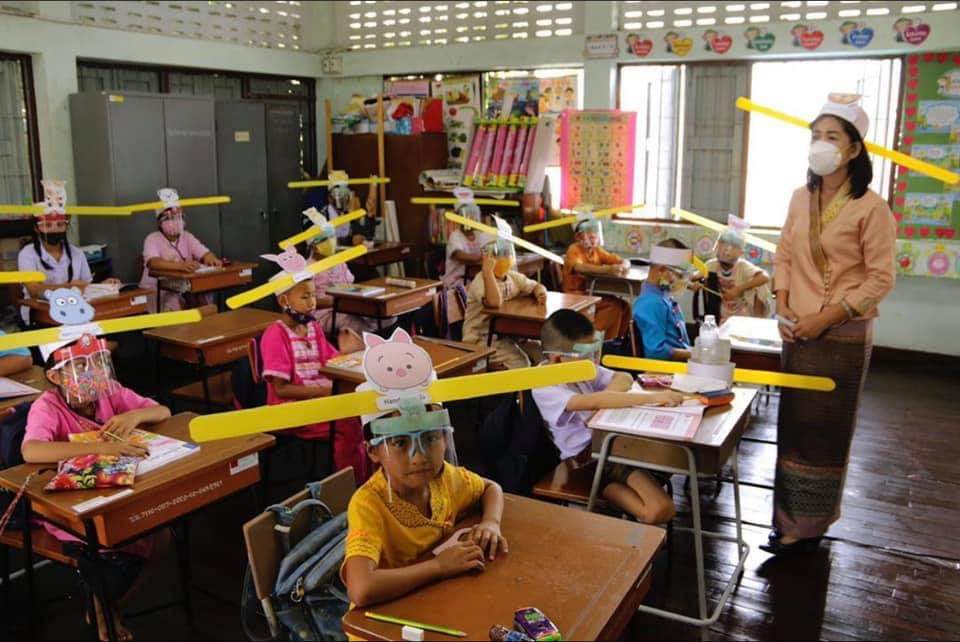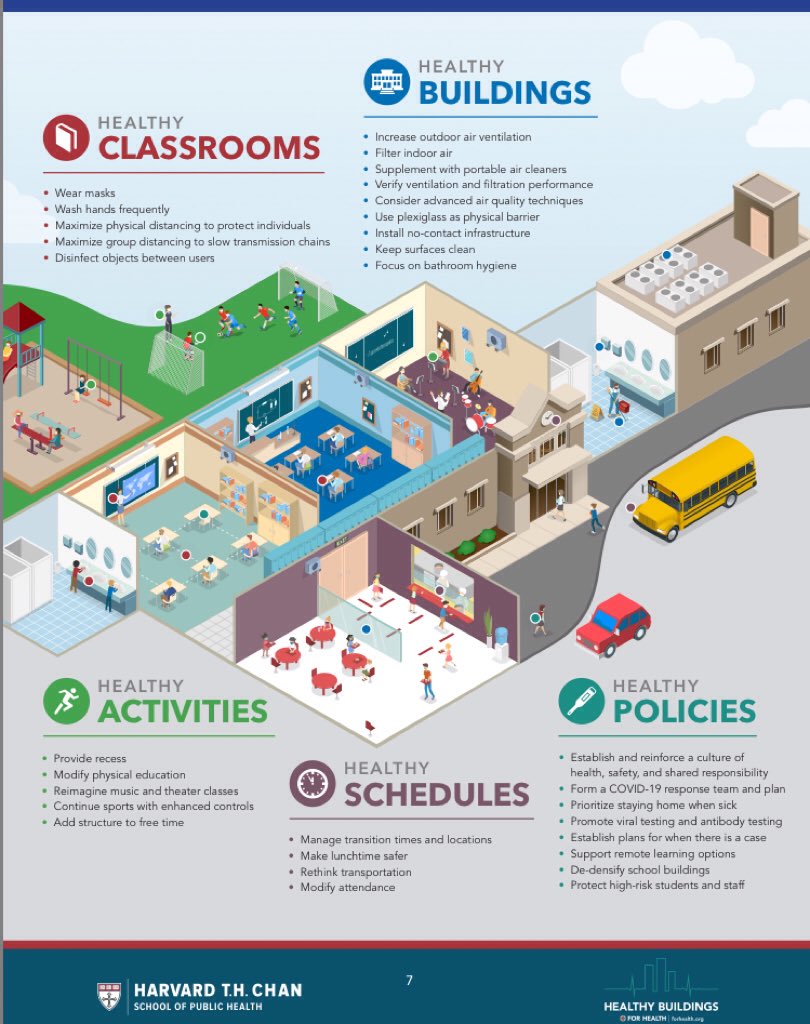1. Updated thread on children and #COVID19, summarising the latest research.
Summary: schools can only reopen safely if community transmission is low, otherwise outbreaks will occur.
#SchoolReopening #edutwitter #edchat #edchatEU #auspol #Schulen #école #enfants
Summary: schools can only reopen safely if community transmission is low, otherwise outbreaks will occur.
#SchoolReopening #edutwitter #edchat #edchatEU #auspol #Schulen #école #enfants
2. First, a recap, showing that child-to-child and child-to-adult transmission of #SARSCoV2 occurs, and that cases in children are being missed (which will affect the findings of some studies published to date). https://twitter.com/DrZoeHyde/status/1272134717039509506?s=20">https://twitter.com/DrZoeHyde...
3. The thread linked to previously has many sub-threads. I& #39;ve linked to an important one below.
It contains evidence that children and adults are equally likely to be infected with #SARSCoV2 given the right circumstances. https://twitter.com/DrZoeHyde/status/1261576137358012417?s=20">https://twitter.com/DrZoeHyde...
It contains evidence that children and adults are equally likely to be infected with #SARSCoV2 given the right circumstances. https://twitter.com/DrZoeHyde/status/1261576137358012417?s=20">https://twitter.com/DrZoeHyde...
4. With that background, here is some of the most important research from the last month or so.
5. This contact tracing study from South Korea shows that children can and do transmit the virus to others in practice, and to a meaningful degree. https://twitter.com/DrZoeHyde/status/1284822227460820992">https://twitter.com/DrZoeHyde...
6. This is unsurprising, because children shed infectious virus just like adults. https://twitter.com/DrZoeHyde/status/1278350818291314689">https://twitter.com/DrZoeHyde...
7. This study describes a #COVID19 cluster at a high school in Israel, demonstrating the potential for mass transmission in the school environment. https://twitter.com/DrZoeHyde/status/1286332165559484416?s=20">https://twitter.com/DrZoeHyde...
8. This study describes a #COVID19 cluster at a K12 school (kindergarten to year 12) in Chile.
Like the outbreak in Israel, the virus spread rapidly through the school community after being introduced. https://twitter.com/DrZoeHyde/status/1283005512720642048">https://twitter.com/DrZoeHyde...
Like the outbreak in Israel, the virus spread rapidly through the school community after being introduced. https://twitter.com/DrZoeHyde/status/1283005512720642048">https://twitter.com/DrZoeHyde...
9. I previously reported this #COVID19 cluster in a French high school. Notable is the effect of the holiday period. New cases dropped markedly after school holidays began. https://twitter.com/DrZoeHyde/status/1255045489277329408">https://twitter.com/DrZoeHyde...
10. Clusters have also been observed in childcare centres. Here, a #COVID19 cluster in a childcare centre in Tokyo is described. https://twitter.com/DrZoeHyde/status/1286309264214986752">https://twitter.com/DrZoeHyde...
11. This cluster in a childcare centre in Melbourne began after a child introduced the virus to the centre. https://twitter.com/DrZoeHyde/status/1286221704654516224">https://twitter.com/DrZoeHyde...
12. Although children experience more mild disease than adults, their ability to transmit the virus to others is important.
In this cluster, most children did not transmit the virus, but two did. One of these transmitted the virus to their grandparents. https://twitter.com/DrZoeHyde/status/1286202562622836737">https://twitter.com/DrZoeHyde...
In this cluster, most children did not transmit the virus, but two did. One of these transmitted the virus to their grandparents. https://twitter.com/DrZoeHyde/status/1286202562622836737">https://twitter.com/DrZoeHyde...
13. Even if most children do not seem to become seriously ill with #COVID19, they likely play a role in community transmission.
Children may have many more contacts than adults (particularly at school) which might offset any reduced tendency to transmit the virus.
Children may have many more contacts than adults (particularly at school) which might offset any reduced tendency to transmit the virus.
14. But what to make of some studies which suggest children pose a lower risk than adults, or even that children are less likely to be infected? Many such studies have important limitations (not least of which is that schools were often closed at the time of the study).
15. When reading a study, it& #39;s vital to think about the context in which it was conducted. For example, if a study shows that few cases occurred in schools, you should ask whether community transmission was low at the time, because it almost certainly was.
16. Such studies mean that schools are low-risk *only* when community transmission is low. Nothing more.
That& #39;s still an important finding however, and should motivate us to eliminate community transmission of the virus so that schools can reopen safely.
That& #39;s still an important finding however, and should motivate us to eliminate community transmission of the virus so that schools can reopen safely.
17. I& #39;ll briefly mention some of the other common problems in studies of children and schools, so you can spot these important limitations and get a better feel for what the study really means.
18. Many studies do not take into account that adult travellers initially seeded epidemics. Because schools were often closed around this time, the potential for spread among children was reduced. Children did not have the opportunity to be infected.
19. In some countries, cases were quickly identified and quarantined in designated centres away from home. This reduced the likelihood of household transmission, and hence the risk to children.
20. Where cases did occur in households, did parents attempt to shield their children at any stage? One could also ask whether children have been shielded by parents in general.
21. Children are more likely to have mild disease than adults, and are frequently asymptomatic. What was testing like in the study? Were all people tested, or only those with symptoms? Sometimes, only those with symptoms were tested.
22. Because children are more likely to be asymptomatic, index cases in children may be missed.
Children may only be tested after an adult (whom they may have previously infected) develops symptoms.
Children may only be tested after an adult (whom they may have previously infected) develops symptoms.
23. In this scenario, the child may incorrectly be thought to be a secondary case (i.e., transmission from child-to-adult was missed, and instead thought to be the other way around).
The case may even go completely undetected because the child& #39;s viral load may have declined.
The case may even go completely undetected because the child& #39;s viral load may have declined.
24. And finally, sometimes testing in children isn& #39;t good, leading to false negatives. https://twitter.com/DrZoeHyde/status/1280503815888920576?s=20">https://twitter.com/DrZoeHyde...
25. Importantly, the problems I have described cannot be fixed by attempting to adjust for various factors during the analysis stage.
If these problems are in the data to begin with, the conclusions of the study are likely flawed.
If these problems are in the data to begin with, the conclusions of the study are likely flawed.
26. What does this all mean for schools?
The key point is that the studies in this thread show that substantial school outbreaks have occurred.
They will continue to occur if community transmission is not suppressed.
The key point is that the studies in this thread show that substantial school outbreaks have occurred.
They will continue to occur if community transmission is not suppressed.
27. Ultimately, schools are as safe as the communities in which they are in.
If there is community transmission, then outbreaks will occur.
Community transmission must be eliminated before schools can open safely. https://twitter.com/DrZoeHyde/status/1283052534253473792">https://twitter.com/DrZoeHyde...
If there is community transmission, then outbreaks will occur.
Community transmission must be eliminated before schools can open safely. https://twitter.com/DrZoeHyde/status/1283052534253473792">https://twitter.com/DrZoeHyde...
28. Once the real problem of community transmission has been addressed, changes to the school environment must be made. The aim is to ensure that a large outbreak does not occur if the virus is introduced to a school.
This doesn& #39;t require high-tech solutions.
This doesn& #39;t require high-tech solutions.
29. Interventions could include the wearing of masks and face shields, staggering of classes, and improving ventilation - perhaps even holding classes outside.
https://twitter.com/DrZoeHyde/status/1279432991287111685?s=20">https://twitter.com/DrZoeHyde...
https://twitter.com/DrZoeHyde/status/1279432991287111685?s=20">https://twitter.com/DrZoeHyde...
30. Once community transmission has been eliminated or reduced to very low levels, relatively simple environmental and behavioural changes can allow schools to reopen with low risk, as seen in East Asia in particular. https://www.straitstimes.com/asia/east-asia/back-to-school-how-life-for-pupils-resumes-amid-covid-19-outbreak-across-east-asia">https://www.straitstimes.com/asia/east...
Addendum: These comprehensive guidelines from Harvard T. H. Chan School of Public Health provide advice on how to manage the risks associated with reopening schools.
 https://abs.twimg.com/emoji/v2/... draggable="false" alt="➡️" title="Pfeil nach rechts" aria-label="Emoji: Pfeil nach rechts"> https://schools.forhealth.org/wp-content/uploads/sites/19/2020/06/Harvard-Healthy-Buildings-Program-Schools-For-Health-Reopening-Covid19-June2020.pdf">https://schools.forhealth.org/wp-conten...
https://abs.twimg.com/emoji/v2/... draggable="false" alt="➡️" title="Pfeil nach rechts" aria-label="Emoji: Pfeil nach rechts"> https://schools.forhealth.org/wp-content/uploads/sites/19/2020/06/Harvard-Healthy-Buildings-Program-Schools-For-Health-Reopening-Covid19-June2020.pdf">https://schools.forhealth.org/wp-conten...

 Read on Twitter
Read on Twitter
 https://schools.forhealth.org/wp-conten..." title="Addendum: These comprehensive guidelines from Harvard T. H. Chan School of Public Health provide advice on how to manage the risks associated with reopening schools.https://abs.twimg.com/emoji/v2/... draggable="false" alt="➡️" title="Pfeil nach rechts" aria-label="Emoji: Pfeil nach rechts"> https://schools.forhealth.org/wp-conten..." class="img-responsive" style="max-width:100%;"/>
https://schools.forhealth.org/wp-conten..." title="Addendum: These comprehensive guidelines from Harvard T. H. Chan School of Public Health provide advice on how to manage the risks associated with reopening schools.https://abs.twimg.com/emoji/v2/... draggable="false" alt="➡️" title="Pfeil nach rechts" aria-label="Emoji: Pfeil nach rechts"> https://schools.forhealth.org/wp-conten..." class="img-responsive" style="max-width:100%;"/>


